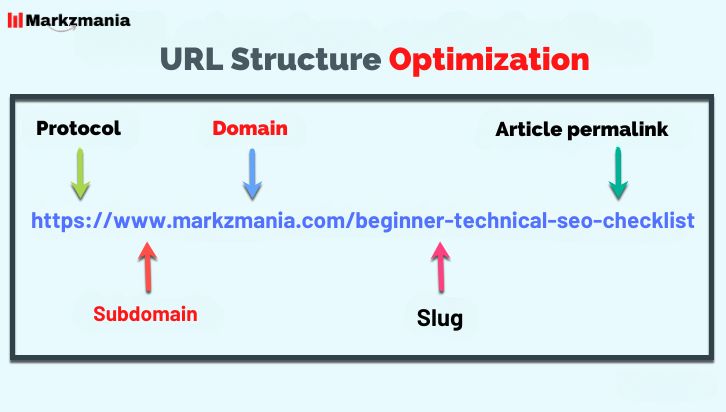Technical SEO checklist, a key element of SEO, focuses on the structure and functioning of your website to ensure that it is ready to rank and perform well in search engine results. If you’re new to SEO, this lesson will walk you through the steps in an easy-to-understand manner. You’ll fully grasp the technical SEO principles once you’ve finished this checklist that Markzmania sent you.
1. Optimize Your Website’s Crawlability
Search engines must be able to locate and comprehend your site’s content to rank it. Here are some tips for making your website easier to crawl:
-
Create and Submit a Sitemap: Create and upload a sitemap, which instructs search engines on which pages to index. Utilize a program like XML-Sitemaps.com to create a sitemap, or hire Yoast SEO or another WordPress plugin to do it for you.
-
Robots.txt File: The Robots.txt file tells search engines which pages to crawl and which ones not to. After placing this file in your root directory, check to make sure important pages are available.
-
Internal Linking: Your site’s links between pages facilitate crawlers’ navigation and help them discover fresh information. Aim for a simple linking structure that allows users to access all of the key pages with only a few clicks.
2. Ensure Mobile-Friendliness
Mobile friendliness is important because most users browse on their mobile devices. Additionally, Google employs mobile-first indexing, which gives priority to indexing and ranking your website’s mobile version.
-
Responsive Design: Verify whether the layout of your website changes to fit different screen sizes. Though they always test across devices, most contemporary themes are responsive.
-
Mobile Usability Test: To evaluate any mobile-related problems, use Google’s Mobile-Friendly Test tool. For a seamless mobile experience, optimize elements like button positioning, text sizes, and image scale.
3. Improve Website Speed
Both search engine rankings and user experience depend on a website’s speed. A sluggish website can increase bounce rates, which will hurt your SEO.
-
Use PageSpeed Insights: This tool from Google helps you find problems that are slowing down your website. It offers recommendations for things like caching, script optimization, and picture compression.
-
Enable Browser Caching: Turn on browser caching to preserve resources on the user’s device and speed up load times for frequent users.
-
Optimize Images: Your website may load more slowly if you have large photos. Make use of compressed files (such as WebP) and adjust the proportions to fit your design. ShortPixel and TinyPNG are useful tools.
4. Activate HTTPS
HTTPS is necessary in today’s web world to ensure that users and your website are connected securely. Google also rewards safer websites with higher rankings.
-
SSL Certificate: Purchase an SSL certificate from a reputable vendor or use free options like Let’s Encrypt. After installation, all URLs should transition from HTTP to HTTPS.
-
Update Internal Links: After turning on HTTPS, make sure that all internal links, images, and scripts are using HTTPS rather than HTTP to avoid “mixed content” notifications.
5. Optimize URL Structure
Both consumers and search engines may more easily comprehend a URL that is clear and organized.
-
Use Short, Descriptive URLs: Steer clear of long URLs that are overflowing with characters. Make them brief, easy to understand, and pertinent to the content instead (for example, markzmania.com/beginner-technical-seo-checklist).
-
Use Hyphens Instead of Underscores: Search engines are more adept at identifying hyphens in URLs than underscores.
-
Avoid Dynamic Parameters: Keyword-rich static URLs are better than ones with dynamic parameters. URLs should be cleaned up for a more structured and search engine-friendly appearance.
6. Optimize Meta Tags
Meta tags like titles and descriptions help search engines and users understand what each page is about.
-
Unique Title Tags: Make sure every page has a distinct title tag that is brief and contains the main keywords associated with that page.
-
Strong Meta Descriptions: Meta descriptions should give a brief overview of the page and be no more than 160 characters. A strong meta description can increase click-through rates even though it isn’t directly used in rankings.
-
Use the H1, H2, and other header tags: Use distinct titles to divide up the content. The primary topic should be represented by an H1 tag on each page, which should be followed by H2 and H3 tags to arrange subtopics.
7. Leverage Structured Data
Structured data (or schema markup) is code added to your website that helps search engines understand the context of your content, making it eligible for rich snippets in search results.
-
Use Schema.org: Make use of Schema.org, which provides standardized markup formats for many categories of content (products, recipes, articles, etc.). This procedure can be made simpler with the use of tools like Google’s Structured Data Markup Helper.
-
Check Your Markup: To make sure it’s implemented successfully and visible to search engines, test it after adding it using Google’s Rich Results Test tool.
8. Fix Broken Links
Broken links lead to a poor user experience and can hurt your SEO by creating crawl errors.
-
Perform a Crawl Audit: You can detect broken links throughout your website with tools like Ahrefs or Screaming Frog.
-
Redirect or Remove: Either use a 301 redirect to the nearest equivalent or update the link to a new, pertinent page. Think about deleting the link completely if there isn’t a relevant page.
9. Optimize Your Images for SEO
The user experience can be greatly improved by images, but they should be optimized to prevent the site from becoming slower.
-
Use Descriptive File Names: Use descriptive file names that contain keywords, such as “technical-SEO-checklist.jpg,” rather than generic names like “IMG_1234.jpg.”
-
Add Alt Text: Alt text is helpful for image search since it tells search engines about the content of an image. Additionally, it enhances accessibility for those who are blind or visually challenged.
-
Select the Right Formats: WebP is a highly compressed format that loads more quickly without sacrificing quality, although JPEG and PNG are the industry standards.
10. Monitor Indexing and Technical SEO checklist
Long-term SEO success depends on monitoring the functionality and condition of your website’s technical components.
-
Make use of Google Search Console: This free tool provides insightful information on how Google is indexing and crawling your website. Keep an eye on it frequently to identify mistakes, indexing problems, and areas that need work.
-
Perform Regular Audits: Perform thorough site audits using SEO tools such as Ahrefs, SEMrush, or Moz. These tools find problems with broken links, duplicate content, site performance, and other technical SEO elements.
-
Set Up Google Analytics: Analytics helps you track user behaviour on your site. With it, you can see which pages perform best, average session times, and where users are dropping off, helping you make informed optimization decisions.
Conclusion
By adhering to these ten technical SEO guidelines, You can ensure your website is optimised and provide a solid basis for future SEO work. Remember that technical SEO is an ongoing endeavour. To stay up to date with search engine algorithms and SEO trends, regularly assess the health of your website and change your procedures.
To improve the functionality and exposure of your website, get in touch with Markzmania for more knowledgeable SEO advice and specialized assistance. Now that you have this checklist, you can start working on a technical SEO checklist and see how your website improves in search results!
Read more blogs like this social media marketing strategy




